

Edutopia. May From Now On. 10 Tips For Launching An Inquiry-Based Classroom. Transforming teaching practices is a long, slow road. But increasingly schools and teachers experiencing success are sharing their ideas online and in-person. Science Leadership Academy opened as a public magnet school almost ten years ago in Philadelphia. The educators that make up the school community have spent nearly half that time sharing best practices through a school-run conference each year and more recently by opening a second school in Philadelphia.
Diana Laufenberg was one of the first SLA teachers and has gone on to help foster inquiry at schools around the country, most recently by starting the non-profit Inquiry Schools. It takes time to build up a strong inquiry-based teaching practice, to learn how to direct student questions with other questions, and to get comfortable in a guiding role. 1. Every teacher has a “bucket” of stuff she is responsible for teaching her students, known as standards. 2. 3. 4. 5. She doesn’t think it’s that different from history. 6. 7. 5 Ways to Help Your Students Become Better Questioners.
The humble question is an indispensable tool: the spade that helps us dig for truth, or the flashlight that illuminates surrounding darkness.
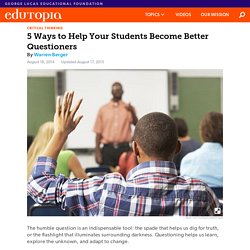
Questioning helps us learn, explore the unknown, and adapt to change. That makes it a most precious “app” today, in a world where everything is changing and so much is unknown. And yet, we don’t seem to value questioning as much as we should. For the most part, in our workplaces as well as our classrooms, it is the answers we reward -- while the questions are barely tolerated. 4 Phases of Inquiry-Based Learning: A Guide For Teachers. 4 Phases Of Inquiry-Based Learning: A Guide For Teachers by Terry Heick According to Indiana University Bloomington, Inquiry-based learning is an “instructional model that centers learning on a solving a particular problem or answering a central question.
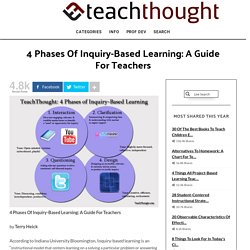
There are several different inquiry-based learning models, but most have several general elements in common: Learning focuses around a meaningful, ill-structured problem that demands consideration of diverse perspectivesAcademic content-learning occurs as a natural part of the process as students work towards finding solutionsLearners, working collaboratively, assume an active role in the learning processTeachers provide learners with learning supports and rich multiple media sources of information to assist students in successfully finding solutionsLearners share and defend solutions publicly in some manner” The process itself can be broken down into stages, or phases, that help teachers frame instruction. 1.
Resources and Downloads to Facilitate Inquiry-Based Learning. A Case for Curiosity: Hear from one educator on the value of asking “why?”
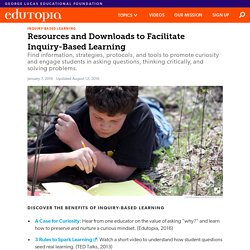
And learn how to preserve and nurture a curious mindset. (Edutopia, 2016) 3 Rules to Spark Learning: Watch a short video to understand how student questions seed real learning. (TED Talks, 2013) Why Curiosity Enhances Learning: Read about findings of a neurological study on curiosity. (Edutopia, 2014) Designing Learning That Matters: Learn about the benefits of inquiry-driven, deep-learning experiences. The importance of surprise.
There should be surprise, delight or even discomfort as one explores.

True inquiry involves discovery. The task at hand should awaken curiosity and take the student on an adventure. Mere topical research requires little more than gathering and is often sleep inducing. It is up to the teacher to frame research projects around questions of import and tasks that require fresh thinking, problem-solving and imagination. The following checklist was designed to help teachers determine whether their research assignments are likely to produce surprise, awaken curiosity and challenge students at the highest possible levels.
To read the full explanation. Harvard Education Publishing Group. Students in Hayley Dupuy’s sixth-grade science class at the Jane Lathrop Stanford Middle School in Palo Alto, Calif., are beginning a unit on plate tectonics.
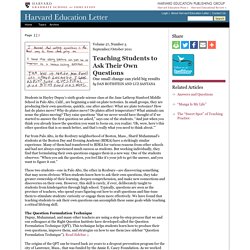
In small groups, they are producing their own questions, quickly, one after another: What are plate tectonics? How fast do plates move? Why do plates move? Do plates affect temperature? What animals can sense the plates moving? Far from Palo Alto, in the Roxbury neighborhood of Boston, Mass., Sharif Muhammad’s students at the Boston Day and Evening Academy (BDEA) have a strikingly similar experience. These two students—one in Palo Alto, the other in Roxbury—are discovering something that may seem obvious: When students know how to ask their own questions, they take greater ownership of their learning, deepen comprehension, and make new connections and discoveries on their own. The origins of the QFT can be traced back 20 years to a dropout prevention program for the city of Lawrence, Mass., that was funded by the Annie E. Question Families. Connecting the Dots In 2009 I outlined this approach in "Connecting the Dots," an article that first appeared in Knowledge Quest, a publication of the American Association of School Librarians.
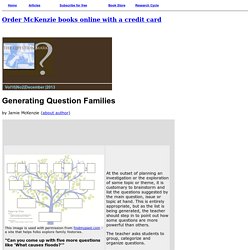
A class exploring the question of what they should do about floods starts with a simple diagram like the one below. But it soon becomes much more complex. Questions are grouped and organized to emphasize causes and effects as well as past efforts and planning issues. This is unlikely to happen unless the teacher helps the group to recognize that questions work best when arranged conceptually. Going Beyond Brainstorming. Nudging Toward Inquiry (AASL 2009)